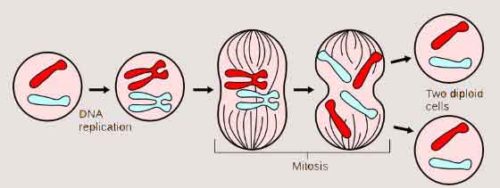The old cells divide to produce new cells. In this case, a single old cell divides into two cells and these two new cells again divide to produce four cells and so on. Generally, this process is known as cell division where a parent cell divides into two or more daughter cells.
The capability of cell division in living organisms is unique and produces more and more cells. In this way, almost two trillion cells are produced in human body every day. According to biologist, the number of cells in human body is around 37 trillion. During the cell division, the parent cells divide to produce two daughter cells and this process occur cyclically, known as the cell cycle. In the perspective of the cell cycle, mitosis is the one kind of the division process where the DNA of the cell’s nucleus breaks down into two equal sets of chromosomes.
Mitosis replaces old, worn-out cells with new ones throughout an organism’s life. Generally, the goal of mitosis is to make sure that each daughter cell gets an absolute, full set of chromosomes. If the cell contains too few or too many chromosomes, they usually don’t function perfectly. Because, these cells cannot survive at all; or they can cause cancer into your body which leads to death.
Based on the type of cells, the cell division occurs two ways: Mitosis and meiosis. Mitosis is the process of one type of cell division by which the mother cell is precisely divided into two new daughter cells that have two new chromosome sets and each daughter cell is genetically identical to the original mother cell while in meiosis, a single cell divide into four daughter cells where the number of chromosomes is reduced by half to produce haploid gametes. In this case, mitosis cell division is good for basic growth, maintenance and repair. But in meiosis, the number of chromosomes is reduced by half which provide for genetic diversity that is important for sexual reproduction.
You might also read: Meiosis, Definition, Stages and Significance
The Cell Cycle or Mitotic (M) Cycle
The mitosis is a cell division process which successfully make the new diploid cells. In continuously dividing cells, an individual cell passes through two main phases of cell or the mitotic cycle or the cell cycle. A growing cell undergoes a cell cycle that consists essentially of two phases i.e., interphase and mitotic phase. The interphase is considered as resting phase of the cell whereas mitotic phase is the most important part of the cycle in which cell divides.
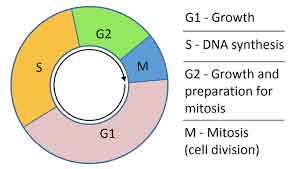
Cell Cycle: Image credit-Wikimedia Commons
Interphase
The interphase is the interval between cell divisions in which growth and synthetic activities take place. This phase is also known as inter-mitotic phase. In this phase, a cell gets ready, grows by gathering nutrients, and energy. The cell also increases in size, produces organelles and DNA is doubled by making a copy during this period. It is divided into the following three phases:
S-phase or Synthetic period
This phase is specific part of interphase in which DNA synthesis occurs. S-phase is replaced and followed by two gap periods of interphase G2 and G1. In this phase, the cell makes a entire copy of the deoxyribose nucleic acid or DNA in its nucleus. It also copies a microtubule-organizing structure called the centrosome. During M phase, centrosome is essential to separate deoxyribose nucleic acid or DNA.
G2-period
It is the interval between the end of S-phase and the start of mitosis. In this phase, the growth of cells occurs more, protein and organelles are made. For the preparation of mitosis, various contents begin to start. G2 period ends and mitosis begins.
G1 period
It is the interval between the end of mitosis and the start of S-phase. In this phase, cells occur physically larger and organelles are copied. This period is also called first gap phase. In this phase, the molecular building blocks are made.
During interphase, the following some characteristic features are observed:
- Growth of both nucleus and cytoplasm occur to maintain normal size of the cell.
- The nucleo-membrane remains intact.
- The chromosomes remain diffused in the nucleoplasm as long coiled thread like chromatin fibres.
- The amount of DNA becomes two times more than in the original diploid cell.
- The nucleolus becomes distinct.
- In animal cell, two centrioles and the centrospheres around the centriole become distinct.
- The most significant events are exact replication of the DNA in the nucleus and related to this, the duplication of the chromosomes from one chromatid to two identical chromatids.
Duration of Cell Cycle
The duration of cell cycle varies greatly from one type of cell to another. For a mammalian, cell growth in culture with a generation time of 16 hours. The length of different period would be G1=5 hours, S=7 hours, G2= 3 hours and mitosis 1 hour. The mitotic periods are relatively constant in the cells of same organism. The G1 period is the most variable in length. Depending on the physiological conditions of the cells, it may last for days, months or years.
Phases of Mitosis
Mitosis occurs in the following four main phases:
(1) Prophase
(2) Metaphase
(3) Anaphase and
(4) Telophase
In some textbooks, they list five phases of mitosis such as prophase, prometaphase, late metaphase, anaphase, and telophase. In this case, they divide the metaphase stage into an early phase, known as prometaphase and a late phase, known as late metaphase.
In the mitotic (M) phase, the cell splits it’s DNA into two sets and divides its cytoplasm, for the formation of two new cells. The main mitotic cell division occurs during mitotic phase. The series of events that make up the cell cycle or mitotic cycle that begins at the end of the G2 period of interphase and terminates at the beginning of G1 period of a new interphase. The main stages of mitosis are mainly divided into Karyokinesis and cytokinesis.
Karyokinesis: It is the division of nuclear material which starts with doubling of chromosome in parent nucleus followed by distribution of between two daughter nuclei in equal proportion. Karyokinesis includes prophase, metaphase, anaphase and telophase.
Cytokinesis: The cytokinesis can take place simultaneously with anaphase and telophase or it can occur at the later stage.
Prophase
It is the first stage of mitosis in which the chromosomes shorten and become visible within the nucleus followed by the dissolution of the nuclear envelope. In this stage, most dramatic changes occur both in the nucleus and cytoplasm.
Changes in the Nucleus
The chromosomes shorten, thicken, become stainable. Here, the X-shaped structure of chromosome occurs if you observe under a microscope. Shortening is due to loss of water from chromatin fiber and spiralization of threads takes place.
Two chromatids are produced from each chromosome. In this case, chromatids bear same genetical information. They are in very close association with each other all along their length. These chromatids are coiled around each other.
During early prophase, the chromosomes are evenly distributed in the nucleoplasm but as prophase progresses the chromosomes migrated towards the nuclear membrane.
The nucleoli gradually diminish in size and eventually the nucleolar material becomes dispersed.
Changes in the Cytoplasm
The centriole (in animal cells) which had undergone duplication during interphase now begin to move towards opposite poles.
The movement of centriols are due to their being pushed apart by growth of the spindle fibres between them. In animal cells or in the lower plants, fibrils appear like spokes of wheel around each centriole to form asters. The ester, the centrioles and the spindle together make up the structure called mitotic apparatus or achromatic figure.
Metaphase
It is the second stage of mitosis in which the chromosomes are attached to spindle fibres in the equatorial plane of the cell. The metaphase can be divided into two phases namely: early metaphase or prometaphase and late metaphase.
Early Metaphase or Prometaphase
The transition between prophase and metaphase sometimes called prometaphase. The following changes occur in this phase:
1. It is the short period in which the nuclear membrane disintegrates.
2. The chromosomes begin to proceed towards the equator.
Metaphase
The following changes occur in this phase:
1. The chromosomes have reached the central or equatorial position of the spindle. They are lined up in one place and thus form the equatorial plate or metaphasic plate.
2. The centrioles lie on the equator of the spindle.
3. The centromeres lie in a plane equidistant from the spindle pole and the arms are directed towards the poles.
4. It is the stage at which chromosomes have reached the point of maximum contraction.
5. Each sister chromatid is attached by the mitotic spindle fibres.
Anaphase
1. Actually, it is the 3rd stage of mitosis in which the centromeres and daughter chromosomes separate and begin to move toward opposite poles. The following changes occur in this phase:
2. The centromeres of the chromosomes divide and the two chromatids of each pair separate. They are called sister chromatids.
3. The sister chromatids migrate towards the poles due to shortening of spindle fibres attached to the centromeres. Separation of the sister chromatids occurs by the action of pulling of mitotic spindle. In this case, one chromatid goes to one pole while other chromatid to the opposite pole by the action of spindle.
4. Pulling of spindle causes the shape of chromosomes. In this case, chromosomes look like v (metacentric), J (acrocentric) or L (submetacentric) shape.
Telophase
It is the 4th or last stage of mitosis in which the chromosomes uncoil and become surrounded by new nuclear envelopes. This stage begins at the end of the polar migration of the daughter chromosomes. The following changes occur in this phase:
1. The chromosomes uncoil.
2. A new nuclear membrane is formed around each mass of chromatin to create two nuclei.
3. Nucleoli reappear at nucleolar organizer present in one pair of chromosomes.
Cytokinesis
During cytokinesis, the cytoplasm of a single eukaryotic cell separates into two daughter cells. In cytokinesis process, the single cell squeezes in the middle position and the partition of spindle apparatus occurs which forms two separate daughter cells. It occurs in a full set of chromosomes inside a nucleus.
This process also ensures that chromosome number and complement are maintained from one generation to the next generation identical to those of the mother cell. After finishing cytokinesis, each daughter cell enters the interphase and repeats the cell cycle.
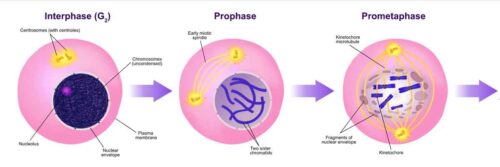
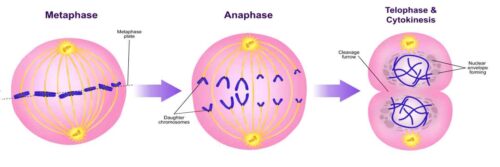
Stages of Mitosis:Image credit-Wikimedia commons
In Animal Cells:
At the beginning, on the outer edges of the cell and midway between the poles, a cleavage furrow occurs. When spindle breaks down, furrow of constriction becomes more deeper. At the final stage, ingrowing constrictions joins and two daughter cells are produced by cleaving the one cell.
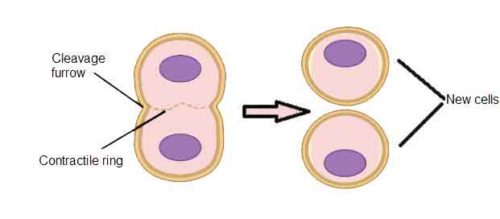
Cytokinesis in animal cell
In Plant Cells
Cytokinesis in plant cell involves the formation of a cell wall between the daughter nuclei. This begins as a cell plates or phragmoplast formed by aggregation of vesicles from the Golgibodies. These vesicles fuse with each other to form cell membranes and cell walls, thereby divide into two parts. The spindle, is then disintegrates and cell division is completed. Thus two cells, each with a nucleus containing a full complement of chromosome have been formed from the original cell.
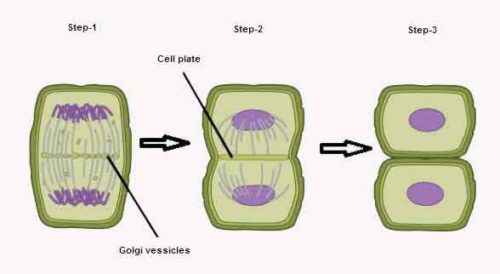
Cytokinesis in plant cell
Plant Vs Animal Cytokinasis
|
Plant Cytokinesis |
Animal Cytokinesis |
|---|---|
|
It is the cytoplasmic division where the plant cell separates into two daughter cells. |
It is also the cytoplasmic division where the animal cell separates into two daughter cells. |
|
It occurs by forming of a cell plate at the middle of the cell due to have a rigid cell wall. |
It occurs by the formation of a cleavage furrow. |
|
In this case, cell walls are formed. |
In this case, cell walls are not formed. |
|
Cell membrane does not constrict. |
In this case, cell membrane constricts. |
|
At the equatorial plane, the cell plate is formed from the vesicles with cell wall materials released from the Golgi apparatus. |
At the equatorial plane, non-muscle myosin II and actin filament assembles and contractile ring forms in the middle of the cell at the cell cortex. |
Significance of Mitosis
The importance of the mitosis has been summarized as follows:
- Mitosis helps the growth and development of organs and the body of the organisms.
- It helps to maintain the proper size and shape of the cell.
- Mitotic cell division replaces the old decaying and dead cells by forming the new cells.
- Unicellular organisms mainly reproduce and multiply by mitosis.
- The essential feature of mitosis is that the chromosomes are distributed equally among the two daughter cells.
- In mitosis, a mechanism for the duplication of chromosomes and for linear arrangement of genes takes place.
- Mitosis helps to maintain the balance between DNA and RNA contents with the nuclear and cytoplasmic contents of the cells.
- Through the mitosis, equilibrium is maintained in the amount of DNA and RNA contents.
- Mitosis also helps the organisms in the asexual reproduction.
You might also read: Difference Between Plant Mitosis and Animal Mitosis

